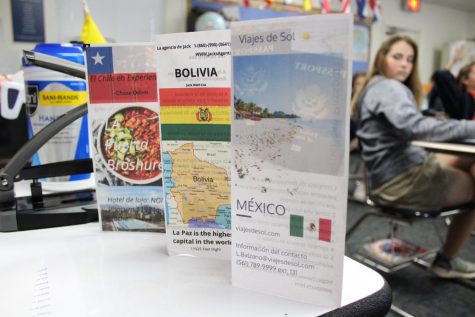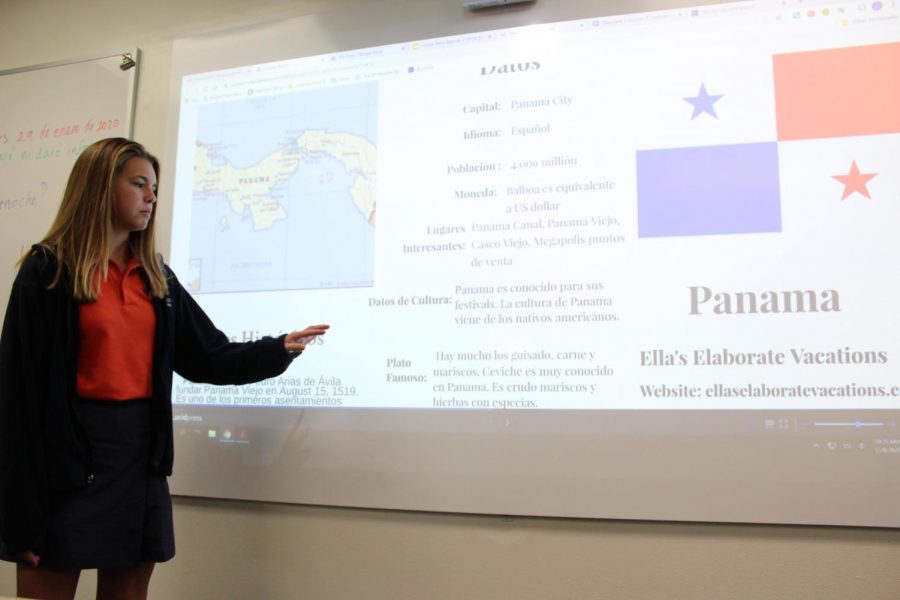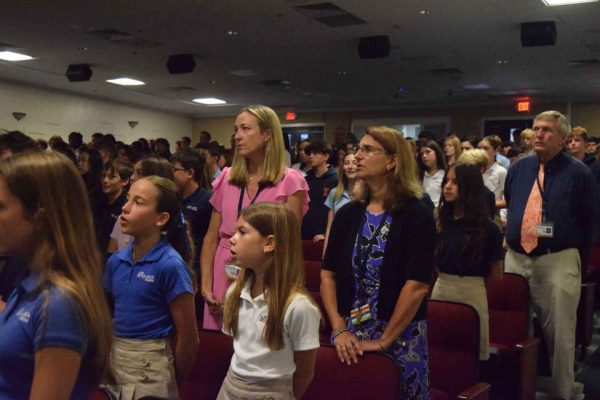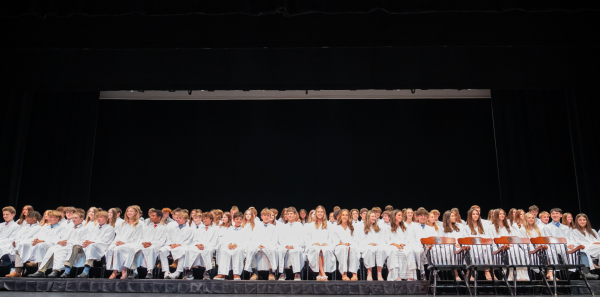More Than Just Learning a Language
World Language Classes Bring Various Cultures to Life through Interesting Activities
Seventh-grader Ella Bailey presents her brochure on Panama.
Mr. and Mrs. Benjamin always believed that their students should not only learn the basics, but also participate in a sport, contribute positively to the community, and learn a foreign language. Sixty years after the beginning of TBS, their legacy lives on. Students today are still held to these standards.

This is an example of a brochure that a student in Mrs. Rios’s class would make.
Throughout the academic year, Benjamin School students do a variety of activities to help them learn their foreign language. These activities vary based on the language the student is taking.
For example, Spanish students are currently working on brochures to learn about different Spanish-speaking countries. The students get to pick a country of their choice and are required to conduct research and learn about the country without sitting in class and taking notes all day long. The Spanish students take a few days to gather information and photos. After that, they use free design software, such as Lucidpress, to create their brochures. Once they finish designing their brochures, they print them out and present what they learned to the class. It’s both engaging and educational.
“I think the brochure project is helpful because it helps my Spanish vocabulary and lets me learn more about Guatemala,” said eighth-grade student Abby Spunar.
“I thought the project was fun and helpful because I was always interested in Colombia, and I finally got to learn about it,” said eighth-grader Tristan Mack.
This project for Spanish students is one of the biggest projects of the year because there are many components that go into making a great brochure, including having factual information.
“This project is important for the students because it helps their Spanish communication skills,” said world language teacher Mrs. Diana Rios. “Students are using the Spanish language learned in class and are applying it to real-life situations. As part of the project, we just visited the STEM Center to watch some virtual reality tours to various Spanish-speaking countries,” she said.
After the brochures are completed, the Spanish students are going to create TV ads using the information from this project. In groups, they will record the ads on their phones and present them to the class.
Chinese language teacher Ms. Kimberly Latimer also tries to deepen students’ learning by having them engage in projects relevant to Chinese culture.
This year her Chinese students are growing rice, a key Chinese crop, to learn more about the culture.
“Rice growing is important to Chinese culture because they have been doing it for thousands of years,” said Latimer. “This long relationship between Chinese culture and the science of agriculture has influenced the development of the Chinese language, the structure of the traditional Chinese house, and [the] Chinese family structure.”
Meanwhile, in French classes, students are also learning about important aspects of French culture. For example, D period French students are learning about certain French-speaking athletes such as Kylian Mbappe and Yanick Noah. Both of these athletes have represented France on the world stage. Noah, for example, won over 23 titles during his career as a professional tennis player, and Mbappe led the French soccer team to a World Cup title in 2018, becoming an international star while doing it.
“Learning about French athletes and celebrities helps me understand French culture because it puts me in the shoes of a person that lives in France and is part of that culture,” said eighth grader, Talia Miller.
According to the World Language Department Chair and French teacher Mrs. Marci York, students also make lasting and relevant connections when they see how other cultures mirror their own.
“Reading about the young soccer star Kylian Mbappe, we see that there are lots of similarities between US culture and French culture,” she said. “Sports are popular in both countries, successful young athletes thrive in both countries, [and] there is a spirit of competition and sportsman-like behavior that is encouraged and appreciated.”
By choosing such creative and engaging activities, the world language teachers are keeping alive one of the fundamental tenets Mr. and Mrs. Benjamin set forth 60 years ago. York also stated “seeing a high-interest article about a handsome young French soccer star is (hopefully) more interesting than simply seeing them as a random list of topics to review before a quiz or test. Sports stars are fascinating, and reading about a modern-day athlete is a way to get students more engaged in the lesson.”





